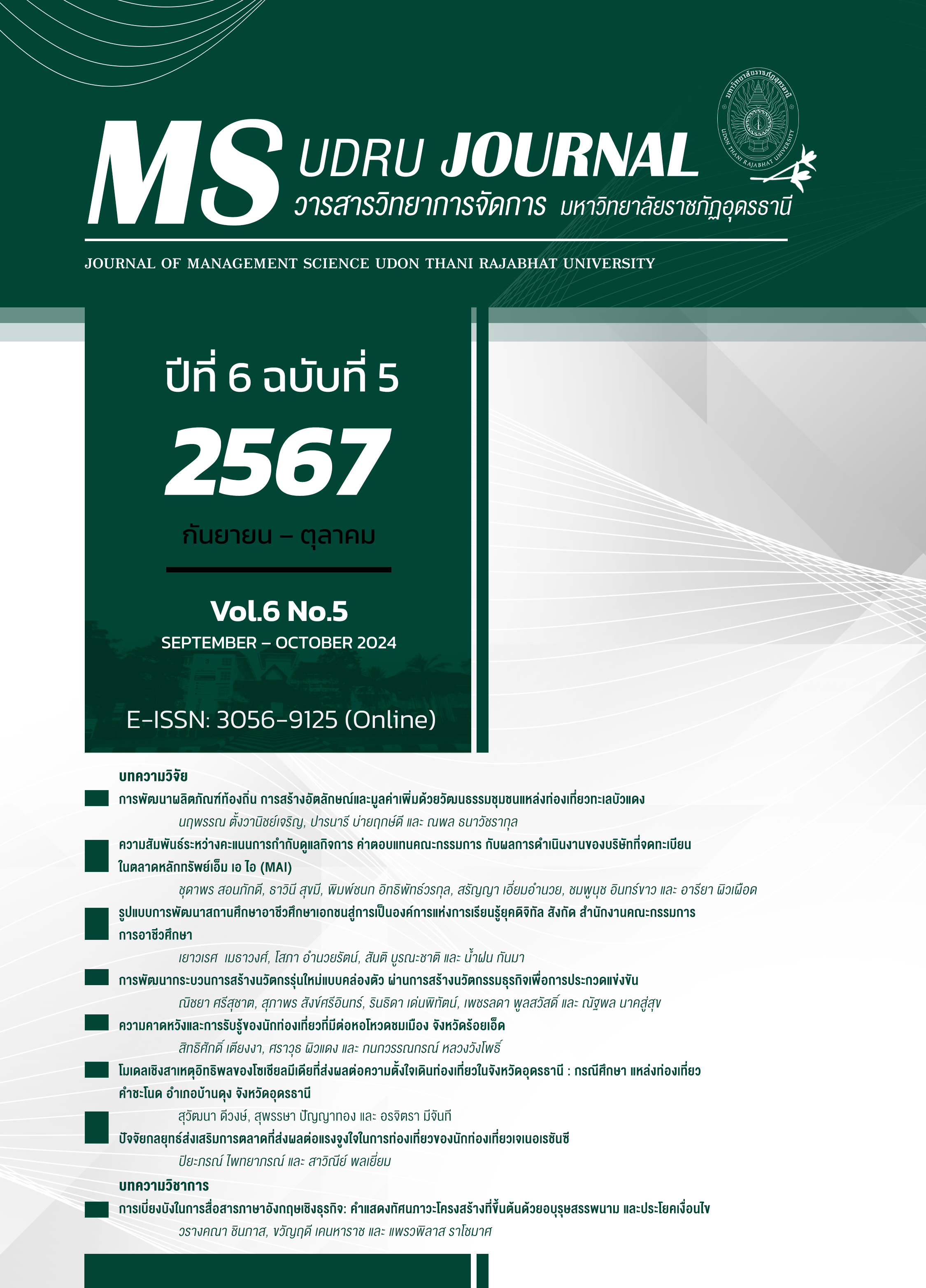ปัจจัยกลยุทธ์ส่งเสริมการตลาดที่ส่งผลต่อแรงจูงใจในการท่องเที่ยวของนักท่องเที่ยวเจเนอเรชันซี
Main Article Content
บทคัดย่อ
นักท่องเที่ยวกลุ่มเจเนอเรชันซี เป็นกลุ่มนักท่องเที่ยวที่มีศักยภาพในการเดินทางท่องเที่ยวในอนาคตอันใกล้ การตัดสินใจส่วนใหญ่ได้รับอิทธิพลหลักมาจากข้อมูลบนอินเทอร์เน็ต การวิจัยในครั้งนี้มีวัตถุประสงค์หลัก เพื่อสร้างสมการพยากรณ์แรงจูงใจในการท่องเที่ยวของนักท่องเที่ยวเจเนอเรชันซี กลุ่มตัวอย่างเป็นนักท่องเที่ยว เจเนอเรชันซีจำนวน 442 คน ที่มีอายุระหว่าง 18 – 29 ปี และเดินทางเข้ามาท่องเที่ยวในจังหวัดอุดรธานี เครื่องมือที่ใช้ในการวิจัยเป็นแบบสอบถามแบบมาตราส่วนประมาณค่า 5 ระดับ สถิติที่ใช้ในการวิเคราะห์ข้อมูล ได้แก่ ค่าความถี่ ค่าร้อยละ ค่าเฉลี่ย ความเบี่ยงเบนมาตรฐาน สัมประสิทธิ์สหสัมพันธ์ของเพียร์สัน และการวิเคราะห์ถดถอยพหุคูณแบบขั้นตอน ผลจากการศึกษา พบว่า ตัวแปรพยากรณ์ทั้ง 3 ตัวแปร ได้แก่ การขายโดยพนักงานขาย การโฆษณาและประชาสัมพันธ์ และการส่งเสริมการขาย มีผลกระทบเชิงบวกแรงจูงใจในการท่องเที่ยวได้อย่างมีนัยสำคัญทางสถิติ โดยตัวแปรทำนายในสมการร่วมกันอธิบายความแปรปรวนของแรงจูงใจในการท่องเที่ยวได้ร้อยละ 21.6 สมการพยากรณ์แรงจูงใจในการท่องเที่ยวคือ
สมการพยากรณ์ในรูปคะแนนดิบ
Y = 2.738 + 0.175 (การขายโดยพนักงานขาย) + 0.112 (การโฆษณาและประชาสัมพันธ์) + 0.088 (การส่งเสริมการขาย)
สมการพยากรณ์ในรูปคะแนนมาตรฐาน
Z = 0.239 (การขายโดยพนักงานขาย) + 0.156 (การโฆษณาและประชาสัมพันธ์) + 0.134 (การส่งเสริมการขาย)
Article Details

อนุญาตภายใต้เงื่อนไข Creative Commons Attribution-NonCommercial-NoDerivatives 4.0 International License.
บทความที่ได้รับการตีพิมพ์เป็นลิขสิทธิ์ของคณะวิทยาการจัดการ มหาวิทยาลัยราชภัฏอุดรธานี
ข้อความที่ปรากฏในบทความแต่ละเรื่องในวารสารวิชาการเล่มนี้
ไม่ใช่ความคิดเห็นและความรับผิดชอบของผู้จัดทำ บรรณาธิการ กองบรรณาธิการ และคณะวิทยาการจัดการ มหาวิทยาลัยราชภัฏอุดรธานี ความรับผิดชอบด้านเนื้อหาและการตรวจร่างบทความแต่ละเรื่องเป็นความคิดเห็นของผู้เขียนบทความแต่ละท่าน
เอกสารอ้างอิง
กัลยา วานิชย์บัญชา. (2556). การวิเคราะห์สถิติ: สถิติสำหรับการบริหารและวิจัย. พิมพ์ครั้งที่ 14. กรุงเทพฯ: จุฬาลงกรณ์มหาวิทยาลัย.
การท่องเที่ยวแห่งประเทศไทย. (2566). สำรวจพฤติกรรมท่องเที่ยว GenZ ว่าที่‘ผู้บริโภคหลัก’ของโลกอนาคต. https://tatacademy.com/th/articles/article/dca34a38-4933-444a-912d-0bee6b1f297f?fbclid=IwAR2JQE-1TxGar0yfq1gGgC3jwrwTJ1K-LjdYDsQssuxlJKCKEZ-0Fs0TENI.
นฤภร ชูสุวรรณ. (2565). การสื่อสารการตลาดแบบบูรณาการ คุณภาพบริการ และแรงจูงใจในการท่องเที่ยวที่มีอิทธิพลต่อการตัดสินใจและความภักดีของนักท่องเที่ยวที่ใช้บริการที่พักเกาะล้าน จังหวัดชลบุรี. ปริญญานิพนธ์บริหารธุรกิจมหาบัณฑิต สาขาวิชาการจัดการ, มหาวิทยาลัยศรีนครินทรวิโรฒ.
ประสพชัย พสุนนท์. (2558). ความเที่ยงตรงของแบบสอบถามสำหรับงานวิจัยทางสังคมศาสตร์. วารสารสังคมศาสตร์ มหาวิทยาลัยศรีนครินทรวิโรฒ, 18(18), 375-396.
พรรษกฤช ศุทธิเวทิน และภูเกริก บัวสอน. (2562). กลยุทธ์ส่งเสริมการตลาดท่องเที่ยวที่มีอิทธิพลต่อแรงจูงใจในการท่องเที่ยวของประชากรรุ่นแซดในเขตกรุงเทพมหานครและปริมณฑล. วารสารธุรกิจปริทัศน์, 11(1), 99-110.
ยุคลวัชร์ ภักดีจักริวุฒิ์ และ เทิดชาย ช่วยบำรุง. (2562). ศักยภาพชุมชน ด้านการส่งเสริมการตลาดการท่องเที่ยวแก่แหล่งท่องเที่ยวโดยชุมชนในพื้นที่พิเศษเมืองพัทยาและพื้นที่เชื่อมโยง. วารสารวิชาการนวัตกรรมสื่อสารสังคม, 7(2), 254-264.
ฤดี เสริมชยุต. (2563). กลยุทธ์การส่งเสริมการตลาด สำหรับการท่องเที่ยวชุมชน. วารสารสังคมวิจัยและพัฒนา, 2(4), 51-61.
ศุภกฤต ปิติพัฒน์. (2565). แรงจูงใจที่ส่งผลต่อความตั้งใจซื้อสินค้าเสมือนในเกมออนไลน์ของผู้บริโภคเจเนอเรชันซี. วารสารเศรษฐศาสตร์และกลยุทธ์การจัดการ, 9(1), 180-197.
ศูนย์วิจัยเศรษฐกิจและธุรกิจ ธนาคารไทยพาณิชย์. (2565). ส่องพฤติกรรมนักท่องเที่ยวแต่ละสาย คุณเป็นสายไหน?. https://www.scbeic.com/th/detail/file/product/8602/getdypugcp/EIC-In-Focus_Consumer-survey-report_Travel-Part-2_20221026.pdf.
สมรศรี คำตรง. (2566). พฤติกรรมนักท่องเที่ยวกลุ่ม Generation Z ในเขตกรุงเทพมหานครและปริมณฑล. วารสารวิชาการเซาธ์อีสท์บางกอก (สาขามนุษยศาสตร์และสังคมศาสตร์), 9(1), 93-107.
สุภัทรา นพฤทธิ์. (2554). แผนการส่งเสริมการท่องเที่ยวแบบสมาธิวิปัสสนากรรมฐานอย่างยั่งยืน สำหรับเยาวชนในเขตจังหวัดขอนแก่น. วิทยานิพนธ์ปริญญาบริหารธุรกิจมหาบัณฑิต สาขาการจัดการการท่องเที่ยว, มหาวิทยาลัยขอนแก่น.
แสงเดือน รตินธร. (2555). ปัจจัยผลักดันและปัจจัยดึงดูดที่มีผลต่อนักท่องเที่ยวชาวจีนในการตัดสินใจเลือกมาท่องเที่ยวในประเทศไทย. วารสารวิชาการสมาคมสถาบันอุดมศึกษาเอกชนแห่งประเทศไทย (สสอท.), 18(2), 84-104.
Baruch, Y. (1999). Response rate in academic studies–A comparative analysis. Human Relations, 52(4), 421-438.
Chi, N. T. K. (2022). Transforming travel motivation into intention to pay for nature conservation in national parks: The role of Chatbot e-services. Journal for Nature Conservation, 68(August), 126226, https://doi.org/10.1016/j.jnc.2022.126226.
Cochran, W. G. (1977) Sampling Techniques. (3rd Ed.). New York: John Wiley & Sons.
Cortina, J. M. (1993). What is coefficient alpha: An examination of theory and applications? Journal of Applied Psychology, 78(1), 98-104.
Francis, T., & Hoefel, F. (2018). ‘True Gen’: Generation Z and its implications for companies. Sao Paulo, Brazil: Mckinsey & Company.
Hinkle, D. E. (1998). Applied Statistics for the Behavior Sciences. Boston: Houghton Mifflin.
Kotler, P. and Armstrong, G. (2012). Principles of Marketing. (14th Ed.). Essex, England: Pearson Education Limited.
Merriman, M. (2015). What if the next big disruptor isn't a what but a who? Gen Z is connected, informed and ready for business. Columbus, Ohio: Ernst & Young.
Naushin, S., & Yuwanond, P. (2016). The Study of Motivation Factors of Tourists in Visiting Cox’s Bazar Sea Beach, Bangladesh. PSAKU International Journal of Interdisciplinary Research, 5(1), 43–52.
Prasongthan, S. (2018). Factors Affecting Intention to Travel of People with Disabilities in Bangkok Metropolitan Region: A Preliminary Study. Asian Administration and Management Review, 1(2), 100–109.
Priporas, C. V., Stylos, N., & Fotiadis, A. K. (2017). Generation Z consumers' expectations of interactions in smart retailing: A future agenda. Computer in Human Behavior, 77(December), 374-381.
Schlossberg, M. (2016). Teen Generation Z is being called 'millennials on steroids,' and that could be terrifying for retailers. http://uk.businessinsider.com/millennials-vs-gen-z-2016-2.
Wood, S. (2013). Generation Z as consumers: Trends and innovation. Institute for Emerging Issues: NC State University, 119(9), 1-3.


